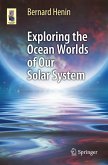In this 2nd edition, we delve into and compare the latest scientific discoveries on 22 confirmed or potential ocean worlds, ranging from the giant asteroid Ceres and the icy moons Europa and Enceladus to the distant dwarf planets of the outer Solar System such as Pluto, Sedna, and Eris. Along the way, we explore the contributions of multiple spacecraft, such as the Pioneers, the Voyagers, Galileo, Cassini-Huygens, and many others, which have provided much of our current knowledge about these worlds, as well as the latest scientific research on this subject.
This book also explores the potential for life on each of the confirmed ocean worlds evaluating their habitability. Ultimately, these might hold the key to answering fundamental questions about life: How did life begin? Is there life beyond Earth? Where do we come from? With contributions from leading planetary scientists at NASA, ESA, and other institutions, this book aims to be the definitive reference for anyone interested in this captivating subject.
Dieser Download kann aus rechtlichen Gründen nur mit Rechnungsadresse in A, B, BG, CY, CZ, D, DK, EW, E, FIN, F, GR, HR, H, IRL, I, LT, L, LR, M, NL, PL, P, R, S, SLO, SK ausgeliefert werden.









